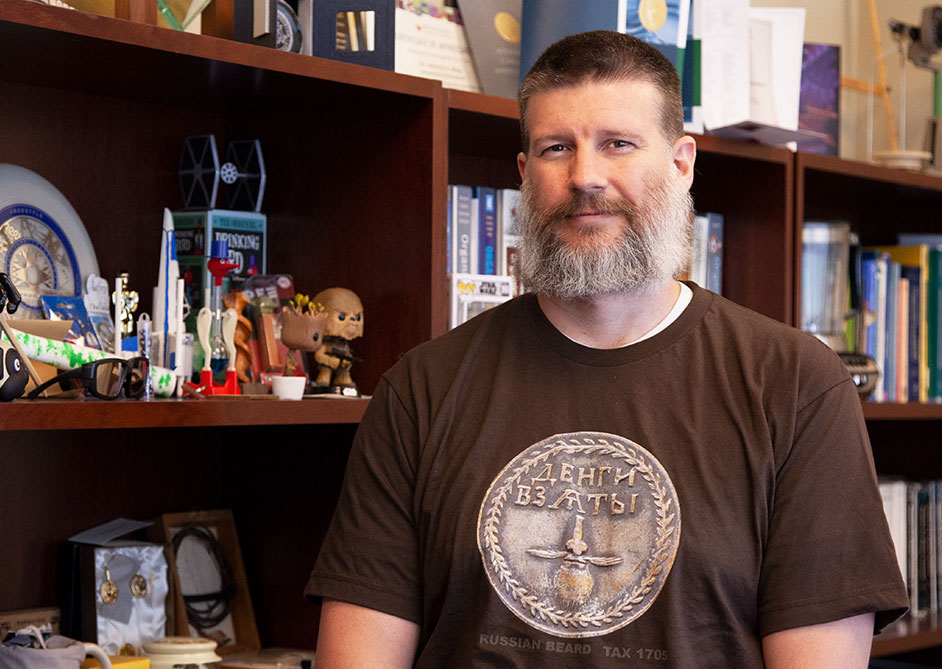Medically Relevant Targets Include THC and Cannabidiol Synthesis and Anti-Cancer Drugs
Jeremy May and his research group will use funding from the National Science Foundation to develop new ways to link molecules with carbon-boron bonds to other organic fragments to quickly access complex molecular structures.

May, professor of chemistry at the University of Houston’s College of Natural Sciences and Mathematics, received a $474,114 grant from the NSF’s Chemical Synthesis Program in the Division of Chemistry. His group will focus on complex chemical motifs, specifically, using the strength of the carbon-boron bond to make bonds between carbon.
Carbon-based molecules are used in many areas of life, whether in medications, polymers, or OLEDs, and there is always a need to make these compounds more efficiently.
Atoms need to be in the correct geometric arrangement, so they interact with biological molecules, like proteins and nucleic acid, in a correct manner. May explains that, not only do scientists need to connect the right atoms, but the three-dimensional structures of the molecules need to be correct as well.
“The research we do in the lab is to figure out how to make carbon-based molecules faster, more efficiently and from simpler, cheaper starting materials,” said May. “At the same time, we want to control the three-dimensional orientation of the molecules.”
Transferring the carbon-boron bond to a carbon-carbon bond is especially powerful, he said, because the boron is a switch that can turn reagents on and off.
In addition, his lab adds a catalyst that not only turns on the reagent and activates the carbon-boron bond, but the catalyst also controls the direction that the reagent is added to the molecule structure.
“In previous work, we have done this with a very specific reaction called a conjugate addition, because there’s electron conjugation,” said May. “With this grant, we are expanding the types of reactions. So instead of just the conjugate addition, now we can do a dozen other reactions and make them a lot more useful.”
May’s Team Targets Medical Use
For example, a specific target May has in mind to demonstrate the power of his group’s chemical synthesis is the synthesis of tetrahydrocannabinol (THC) and cannabidiol. The lab is about to publish the shortest-ever reported synthesis of the two compounds found in cannabis.
“We don’t necessarily need more of those specific compounds, but if you think about being able to alter their structure, you pretty much have to build a different structure from scratch,” he said. “Given the fact that we can now start switching out pieces and changing the structure of cannabidiol or THC, can we get to where we have the pain relief properties or the appetite-control properties, but you would still have a drug that you can take and drive down the street legally?”
Other medicinally relevant targets of his grant include cytoblastin, which increases the strength of the immune system and upregulates T-lymphocytes. Another target is discoipyrrole D, which inhibits cancer metastasis.
“One of the things we would like to do down the road is build a library of compounds with this chemical motif, now that we have this powerful reaction,” May said. “Maybe there are other biological activities out there to be discovered.”
Reinstating Outreach to KIPP School
The grant will also support outreach to KIPP Sharpstown Junior High, a liberal arts-focused school in Houston, to introduce the students to experimental chemistry and other physical sciences. The partnership was established in 2012 but was on hiatus for two years due to COVID-19. It provides disadvantaged and at-risk students the opportunity to bolster their scientific understanding and desire to prepare for college.
“I’m an advocate that more people need exposure to chemistry,” May said. “It’s the most difficult of the physical sciences to connect with, for most people. With physics, there is astrophysics, which has amazing visuals. With biology, it is easy for people to relate to. Chemistry is everything we personally experience while interacting with the world. Yet so few people spend time thinking about it. So that’s the first point, just getting them to think about the chemistry behind the stuff they see every day.”
The partnership involves May, his graduate students and undergraduate students conducting experiments at the school, sharing what research is like and talking about the impact education has had on their life.
“It’s a great match because of the diversity of the University of Houston,” said May. “The hope is students at KIPP can visualize themselves in these positions.”
- Rebeca Trejo, College of Natural Sciences and Mathematics